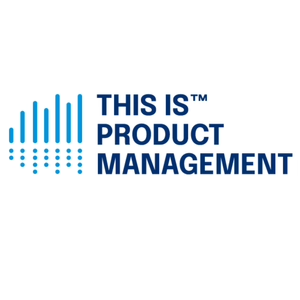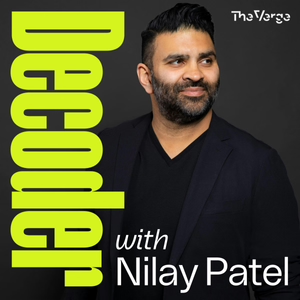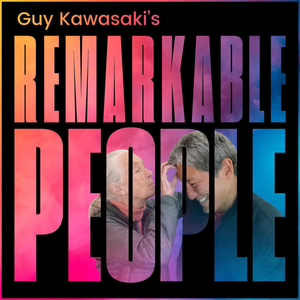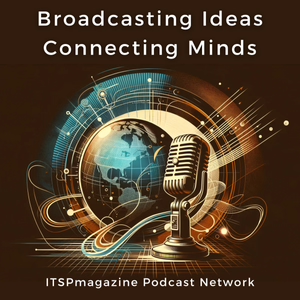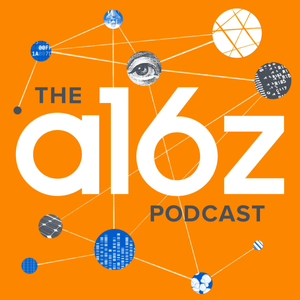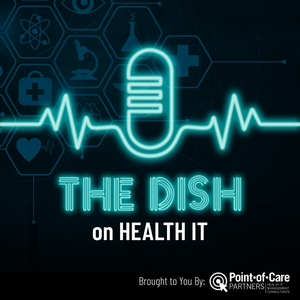
Part 1, Episode 4: HIEs Now & Future
06/10/20 • 29 min
Guest, Dr. Tim Pletcher, Executive Director of the Michigan Health Information Network Shared Services (MiHIN) joins The Dish on Health IT panel of senior consultants, Gary Austin, Jocelyn Keegan and Ken Kleinberg to discuss the role of Health Information Exchanges in healthcare, their role in the response to COVID-19 and what role they can serve in the future once TEFCA is finalized.
Gary Austin kicked off the episode by having Ken and Jocelyn give their perspective on HIEs. Ken went on to provide a primer on the history of HIEs and their varying role depending on the model before going on to mention that the Trusted Exchange Framework and Common Agreement (TEFCA) may change the ecosystem once finalized.
Dr. Pletcher explained that the MiHIN Group is comprised of 3 companies: MiHIN, Velatura & Interoperability Institute. Each company serves a specific purpose. Velatura was created to stay aware of what is happening at the national level and to operate nationally. The Interoperability Institute is a research and development group staffed by interns who are the next generation of Health IT professionals.
HIEs were compared to public commons, like parks and good roads and bridges that people want to have but don't necessarily want to pay for. Dr. Pletcher pointed out that many HIEs were created prematurely before EHR standards and adoption was where it needed to be for valuable data exchange.
Ultimately the value model for MiHIN is based on use cases that are then driven to mass adoption. The value lies primarily with the government and health insurance companies so payers primarily pay for MiHIN service so providers are incentivized to improve data quality while being subsidized to change their workflow to do so.
What's the difference between the successful HIE vs struggling models? Dr. Pletcher pointed out that it's centered around the value the HIE is bringing to each stakeholder and building upon it over time while following the money.
Jocelyn added that solving real problems and talking about the elephants in the room to deal with barriers head-on is crucial. She offered that having MiHIN join the HL7 Da Vinci Project is hastening progress. There is an opportunity for HIEs to reinvent themselves as more flexible API standards are developed and take advantage of fielded codifiable exchange tools to get things into real production environments and take out custom codes and massive production efforts.
The team continued to discuss the financial model of HIEs and how they may evolve post-COVID-19. Will there be more government funding after COVID-19 calms down? Maybe, but there are a lot of people in need and the general funds at the state level are tapped. There may be some federal programs that look toward automation to cut down on some of he manual processes that are still eating up resources. There may be other non-government revenue streams that open up either with employers or by offering telehealth services at the HIE level.
Jocelyn pointed out that while streamlining and making data liquid in general (whether through HIEs or just better adoption of APIs in general) is a money saver for health systems and payers, patients also win through getting better, more informed care and ultimately leading to better outcomes.
Part 2 of this conversation is coming soon!
Guest, Dr. Tim Pletcher, Executive Director of the Michigan Health Information Network Shared Services (MiHIN) joins The Dish on Health IT panel of senior consultants, Gary Austin, Jocelyn Keegan and Ken Kleinberg to discuss the role of Health Information Exchanges in healthcare, their role in the response to COVID-19 and what role they can serve in the future once TEFCA is finalized.
Gary Austin kicked off the episode by having Ken and Jocelyn give their perspective on HIEs. Ken went on to provide a primer on the history of HIEs and their varying role depending on the model before going on to mention that the Trusted Exchange Framework and Common Agreement (TEFCA) may change the ecosystem once finalized.
Dr. Pletcher explained that the MiHIN Group is comprised of 3 companies: MiHIN, Velatura & Interoperability Institute. Each company serves a specific purpose. Velatura was created to stay aware of what is happening at the national level and to operate nationally. The Interoperability Institute is a research and development group staffed by interns who are the next generation of Health IT professionals.
HIEs were compared to public commons, like parks and good roads and bridges that people want to have but don't necessarily want to pay for. Dr. Pletcher pointed out that many HIEs were created prematurely before EHR standards and adoption was where it needed to be for valuable data exchange.
Ultimately the value model for MiHIN is based on use cases that are then driven to mass adoption. The value lies primarily with the government and health insurance companies so payers primarily pay for MiHIN service so providers are incentivized to improve data quality while being subsidized to change their workflow to do so.
What's the difference between the successful HIE vs struggling models? Dr. Pletcher pointed out that it's centered around the value the HIE is bringing to each stakeholder and building upon it over time while following the money.
Jocelyn added that solving real problems and talking about the elephants in the room to deal with barriers head-on is crucial. She offered that having MiHIN join the HL7 Da Vinci Project is hastening progress. There is an opportunity for HIEs to reinvent themselves as more flexible API standards are developed and take advantage of fielded codifiable exchange tools to get things into real production environments and take out custom codes and massive production efforts.
The team continued to discuss the financial model of HIEs and how they may evolve post-COVID-19. Will there be more government funding after COVID-19 calms down? Maybe, but there are a lot of people in need and the general funds at the state level are tapped. There may be some federal programs that look toward automation to cut down on some of he manual processes that are still eating up resources. There may be other non-government revenue streams that open up either with employers or by offering telehealth services at the HIE level.
Jocelyn pointed out that while streamlining and making data liquid in general (whether through HIEs or just better adoption of APIs in general) is a money saver for health systems and payers, patients also win through getting better, more informed care and ultimately leading to better outcomes.
Part 2 of this conversation is coming soon!
Previous Episode

Part 2: Health IT and the Law
The panel and guest, David Szabo, Co-Chair of the Health Care practice, a Partner in the Corporate and Transactional Department, and a member of the Privacy & Cybersecurity Practice Group with Locke Lord, LLP continued the discussion from Part 1 by shifting the focus to the complexities of price transparency. Not only with what data is needed to provide meaningful information about the price patient's can expect to pay but to how widely this information should be expected to be shared without crossing a line to reveal contract details that companies may feel are proprietary. There has been a push by this administration to increase transparency of contract prices as well. This has been responded to in a patchwork of approaches. Ultimately, the panelists and guest agreed that the importance and impact of price transparency on patients is different in situations whether the patient is experiencing a chronic illness or an acute episode. When a patient is in the middle of an emergency shopping around for price goes out the window. Price transparency for chronic or scheduled elective procedures may be where work around meaningful price transparency will progress more quickly.
The panelists and guest then moved to discuss data privacy and patient consent. As patients begin to adopt 3rd party health apps and consent for their physicians to share their data with these 3rd party applications, data privacy no longer falls under HIPAA. Physicians may play a role in encouraging patients to carefully read privacy policies for these apps, however, physicians ultimately don't have any control over what the patient chooses to do with their data. The discussion talked about the philosophy driving these rules is the fervent belief that the more data patients have, the better decisions they will make which remains to be seen.
Data in these apps could be used by pharmaceutical companies to better track efficacy data in the real world.
Will FTC have a bigger role in enforcement/protection of health data shared with 3rd party apps? Szabo felt that congress would need to grant more powers to FTC for them to get into the role of mandating a minimum amount of protections versus their current role which is to investigate after a breach or misuse of data has already occurred.
What should payers, health IT vendors, and providers be doing? Szabo recommends that everyone get ready. Have an interoperability policy that addresses your obligations and lays out a framework for the rules and exceptions. Ken added that stakeholders should take this time to consider how their policies and long term health IT strategies will make healthcare better rather than meet the minimum regulations requirements.
Next Episode

Part 2, Episode 4: HIEs Now & Future
The discussion continues with guest, Dr. Tim Pletcher, Executive Director of the Michigan Health Information Network Shared Services (MiHIN) joins The Dish on Health IT panel of senior consultants, Gary Austin, Jocelyn Keegan and Ken Kleinberg to discuss the role of Health Information Exchanges in healthcare, their role in the response to COVID-19 and what role they can serve in the future once TEFCA is finalized.
Part 2 of the discussion jumps in with how MiHIN responded to COVID-19 by creating a separate group to serve public health needs during the crisis. MiHIN also created a telehealth service to better serve patients and support stay at home orders.
Dr. Pletcher explained they acceleration the connections with labs and expressed his desire for results to be sent back via API instead of batch files to expedite results availability. Data links and analytics have taken on a whole new role during this time.
MiHIN has taken on a support role which may have pumped the brakes on some innovation projects but there has been opportunity to increase the priority of other projects that could directly positively impact the pandemic response.
Jocelyn explained why its so important to meet people where they are in order to make progress. This time is also a time for these simulated barriers to drop. She asked Dr. Pletcher how MiHIN is dealing with perceived security issues when working with innovation projects or partnering with new stakeholders.
Dr. Pletcher responded by saying that their biggest challenge right now are Quest and Labcorp because they don't like to share data but this will be resolved through government intervention. The issues generally are not technical issues but business issues with one partner either not wanting to share data or restricting how the data can be used.
The group went on to discuss how dropping the rules to facilitate the use of telehealth more readily will be a huge driver for change and innovation and hopefully the rules will remain suspended because patients should have more access via telehealth even over state lines.
The conversation moved to data blocking with Gary pointing out EHRs are usually the ones getting the finger pointed at them for data blocking. Dr. Pletcher expressed that Epic or Cerner have never blocked or withheld data in Michigan so he doesn't know who it really is doing the data blocking.
Will the US do more around pandemic surveillance like Taiwan and South Korea? Will HIEs support something like? Ken pointed out that some people don't want to be tracked in this way and will opt out or avoid it, however, if it's the only way a person is allowed to get into a ball game or something, they likely will. Dr. Pletcher explained that opt-in and opt-out is an archaic concept. There is a much better framework which would allow patients to express a more granular desire of how they want their data to be used. Doctors have choices too and when patients consent to receive treatment, physician choices come into play.
The group highlighted where there are similarities between the financial and healthcare industries related to security and data access until the complexities of healthcare ends the similarities with identity being a major hurdle. With the explosion of patient apps, there is also a trust factor the that comes into play as far as understanding what data that can be obtained from patients apps can be trusted and whether they will look at HIEs as the consolidator of data vs going to Payers.
If you like this episode you’ll love
Episode Comments
Generate a badge
Get a badge for your website that links back to this episode
<a href="https://goodpods.com/podcasts/the-dish-on-health-it-121187/part-1-episode-4-hies-now-and-future-8887344"> <img src="https://storage.googleapis.com/goodpods-images-bucket/badges/generic-badge-1.svg" alt="listen to part 1, episode 4: hies now & future on goodpods" style="width: 225px" /> </a>
Copy
